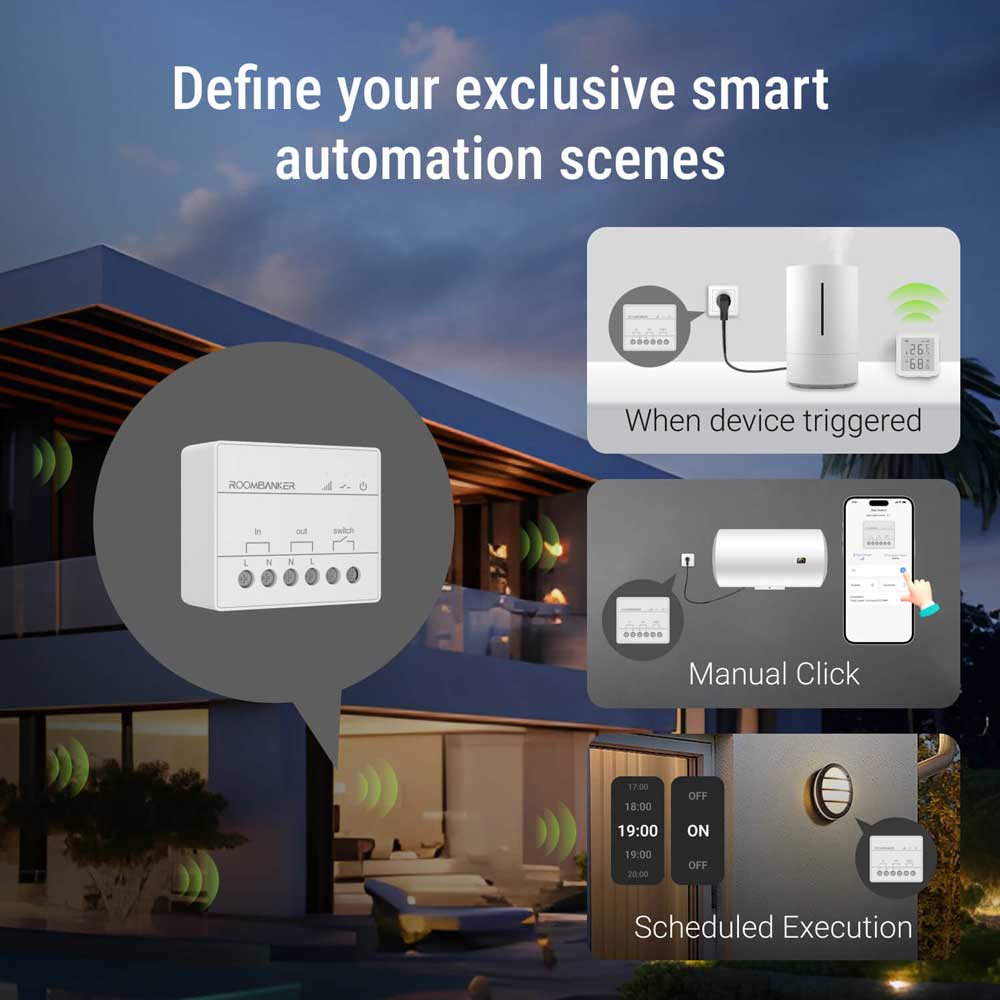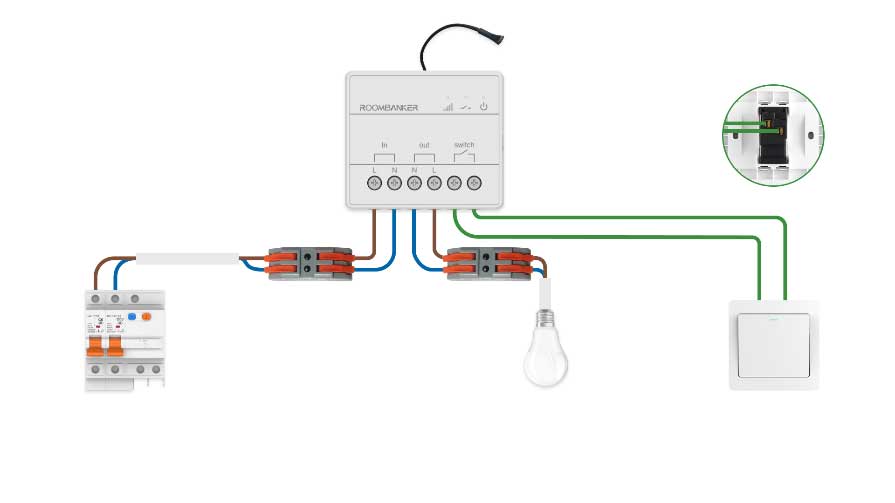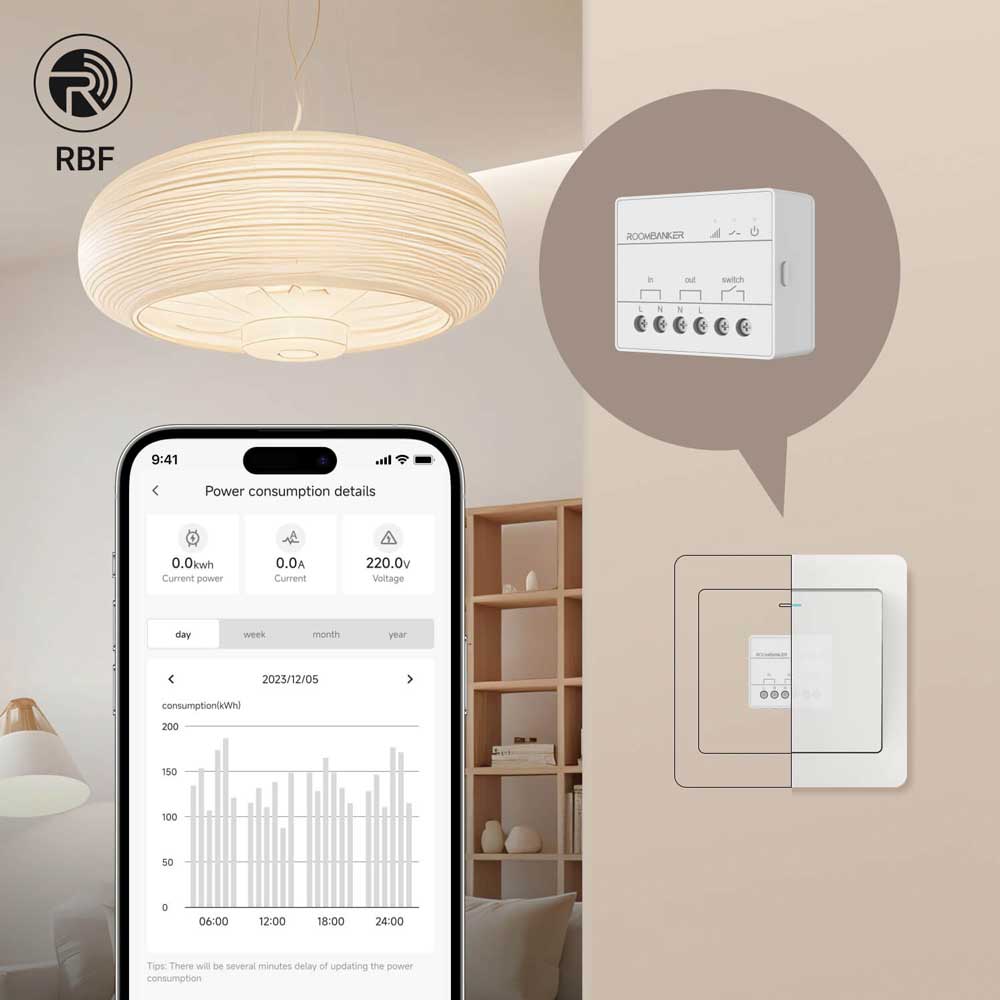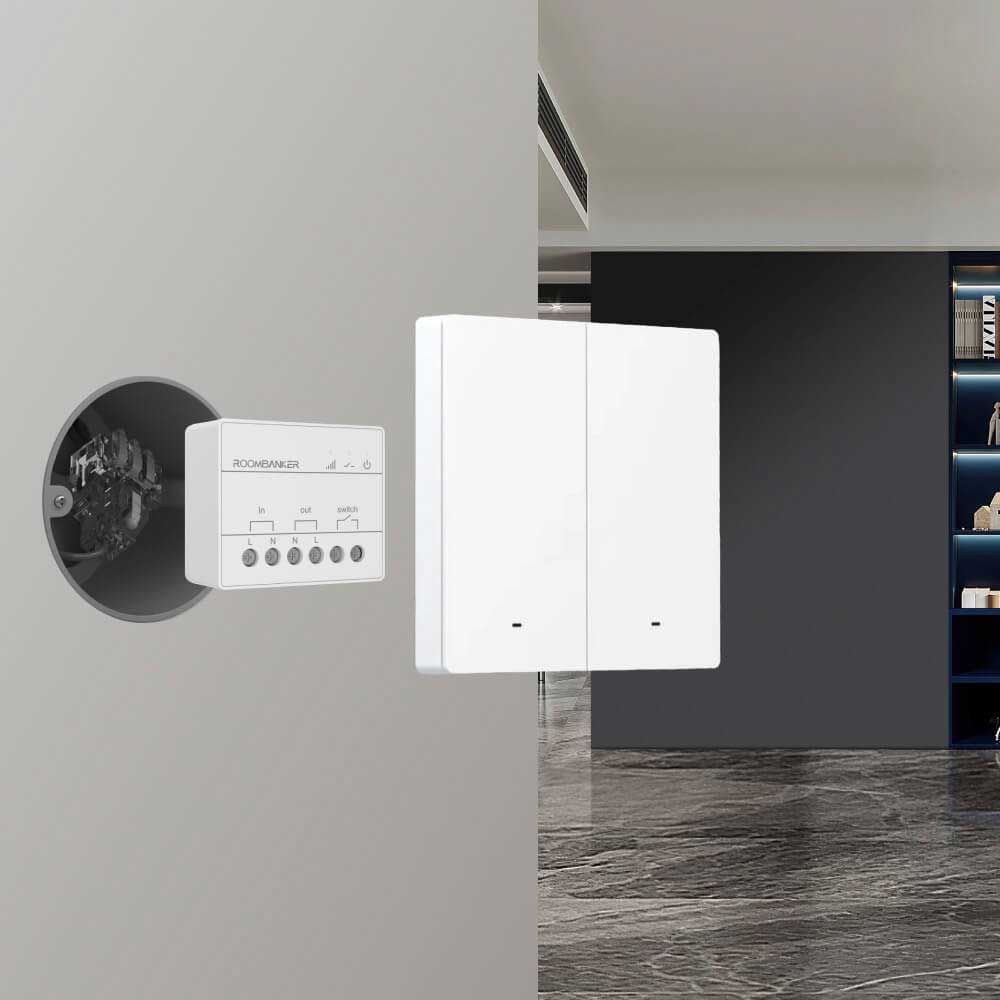Automatic light on/off switches are becoming increasingly popular in IoT-based home automation and energy management systems. They are especially important in energy-efficient lighting systems in today’s smart home solutions. These touch-free devices enhance convenience and sustainability by reducing energy waste.
Automatic light on off switch can be triggered through various methods:
- manual control;
- sensor-based activation;
- app control;
- scheduled operation.

By integrating these advanced technologies, smart homes can achieve an eco-friendly lighting experience, making them an important component of today’s intelligent living environments.
How Does Automatic On Off Switch Work with Lighting?
Smart wall switches can transform existing lighting into smart lighting, allowing users to control them remotely or integrate them into smart home routines. You only need to connect the Wall Switch to the light control circuit. This can transform your lighting system without extensive rewiring.
General Wiring Overview (For informational purposes only)

Important Safety Note
While the following general steps provide a basic overview, electrical work can be dangerous. To ensure safety and proper installation, we strongly recommend consulting a qualified electrician, especially if you’re unfamiliar with electrical wiring.
The wiring diagram illustrates the typical wiring for a smart wall switch. Here’s a breakdown of the connections:
Power Input (Left two terminals, can be connected to the 110V or 230V AC power supply):
- L Terminal: Connects to the live wire in your existing lighting circuit, carrying the electrical current.
- N Terminal: Connects to the neutral wire in your existing lighting circuit, completing the circuit.
Light Output (Middle two terminals):
These terminals connect directly to your light fixture or other home appliances, replacing the traditional switch connections.
Manual Switch Option (Right two terminals):
These terminals allow you to connect an optional manual push-button switch.
- With Manual Switch: Connect a switch here to retain the traditional on/off functionality alongside smart controls.
- Without Manual Switch: Leave these terminals empty if you prefer to control the lights entirely through the smart switch app or voice commands.
Ways to Control Automatic Light On & Off Switches
After the basic configuration with existing lighting or home appliances, it enables users to control lights in the following exciting new ways:

Automatic light on off via smart sensor synchronization:
This method utilizes various smart sensors to trigger and a home security hub to automate the switching of light bulbs.
For example, when you arrive home at night and open the door, a door sensor is activated. The sensor then sends a signal to the home security hub, which relays it to the Wall Switch.
Then, the Wall Switch closes its control circuit, and the lights are turned on automatically. This setup ensures that your living room lights turn on automatically as soon as you open the door and enter your house, providing immediate illumination and enhancing convenience.
Using app to control lights in house:
With the RB Link smart home app, you can remotely control your lighting system. You only need to select the Wall Switch on the RB Link APP and click the switch button on the phone screen to remotely control the lights on and off.
This feature allows you to manage your home lighting no matter where you are. This allows you to turn off lights you may have forgotten or adjust brightness as needed. This remote control capability adds a significant layer of flexibility and energy efficiency.
Schedule Lighting Routines via app time plan:
This adds convenience and even enhances home security when you’re away.
The App time plan allows you to create custom lighting schedules. You can set custom times on the App to automatically turn lights on or off, such as the day, hour, minute, and second. When the Wall Switch control line is turned on or off, the corresponding light bulb will be turned on or off at that time point.
This feature is particularly important for maintaining a consistent lighting routine, which enhances home security when you are away. It also adds convenience by automating the daily lighting needs, such as turning lights on in the morning or off at bedtime.
Info Box
All three control methods require a home security hub. The hub sends instructions to the Wall Switch, and the Wall Switch can control the opening and closing of the line. The hub plays the role of a signal transfer hub, and the mobile app serves as the overall control end, configuring various control logics.
Wireless Technologies Used By Automatic Light On Off Switch
Automatic light On Off switch utilizes various wireless technologies to provide enhanced convenience and energy efficiency. Among the most popular wireless technologies are the following:
Wi-Fi
Wi-Fi is a popular wireless technology option used by automatic light On Off switches because of its high data transfer rates, robust range, widespread availability, and ability to easily integrate with other smart home devices.
WiFi is commonly used in cameras, doorbells and other smart devices that require real-time video transmission. It can be compatible with the existing wireless network in the home and is easy to use.
However, it can be power-intensive and may require a robust network infrastructure to ensure reliability and responsiveness.
In automatic light switches, WiFi smart switch allows users to control lights remotely via smartphone apps or voice assistants, such as Amazon Alexa and Google Assistants.
Zigbee
Zigbee is a low-power, low-data-rate wireless technology designed particularly for home automation. It operates on the IEEE 802.15.4 standard and creates a mesh network, where each device can act as a repeater to extend the range and reliability of the network.
Its low power consumption and robust network self-organizing capabilities make it suitable for large-scale home device connections, such as smart light bulbs, sensors, door locks and other equipment.
Automatic light switches using Zigbee benefit from its robustness and scalability. This makes Zigbee ideal for large installations. Zigbee’s power efficiency ensures long battery life for devices. However, it requires a dedicated Zigbee hub or bridge to connect to the home’s Wi-Fi network and internet.
Z-wave
Z-wave, like Zigbee, is a low-power wireless technology designed particularly for smart home and security alarm systems with medium data rates and transmission distances.
It adopts a mesh network structure to support relay communication between devices to enhance signal coverage and network stability. Therefore, it is suitable for use in scenarios requiring reliable communication over larger areas.
Operating in the sub-1 GHz frequency band, Z-Wave is less prone to interference from Wi-Fi, Zigbee and other household devices. than Zigbee, which operates on the crowded 2.4 GHz band.
Z-Wave devices have undergone strict certification to ensure interoperability between different brands. It is widely used in fields such as smart lighting, security alarm, indoor environmental monitoring, and home appliance control, providing stable, reliable, and low-power solutions.
Z-Wave automatic light On Off switches are known for their interoperability and ease of installation, but like Zigbee, they typically require a central Z-Wave gateway hub.
BLE
BLE is an energy-efficient version of Bluetooth designed for short-range communication. It is commonly used in IoT-based smart homes, health monitoring, wearable devices and other IoT applications.
BLE has the characteristics of fast connection speed and extremely low power consumption, which can extend battery life. Its widely supported standards and protocol stacks ensure device interoperability and compatibility, and are suitable for application scenarios that require frequent data transmission and high battery life requirements.
However, BLE typically has a shorter range compared to Wi-Fi, Zigbee, and Z-Wave, which can be a limitation in larger homes.
BLE-enabled automatic light switches can be controlled directly from smartphones and tablets without needing a central hub. This makes the setup simpler and more cost-effective.
RBF
RBF protocol, developed by Roombanker, is a two-way radio protocol with outstanding long-range communication capabilities, low power consumption and high security data transmission performance.
RBF provides a reliable solution for smooth interaction between home security hubs and wireless peripherals. This protocol supports the longest stable communication distance of up to 3500m in the open state, and can easily cover villas, small and medium-sized shops and other places of use.
The ultra-low power consumption characteristics of RBF technology make the normal operating current of the device less than 2uA, effectively extending the battery life of smart IoT devices and making it an ideal choice for smart home and security scenarios.

Benefits Brought by Automated Light Switch
Here are the benefits of using automated lights On Off switch:
Automated lighting control:
Automated light On Off switches allow for automatic control of lights through timer settings, sensor triggers, and remote control. They can adjust the switching times according to sunrise and sunset times, or automatically turn off lights when the home is unoccupied. This automation not only improves convenience and intelligence of lights but also ensures optimal use of lighting.
Convenient installation
Installing automatic light On Off switches is relatively simple and quick. They integrate easily with the existing control circuits without the need to replace lamps or rewiring. At the same time, these switches retain the functionality of the original manual light switches, making the transition to smart lighting systems time-efficient, effortless, and convenient.
Energy saving and eco-friendly
Automatic lights On Off switches automatically monitor and count power consumption data, including real-time power consumption status, historical power consumption, etc. in real-time and historically. This data allows users to optimize their power consumption plans based on the data.
At the same time, automated light On Off switches can adjust the light usage time according to needs. For example, they automatically turn off the lights when no one is around. This significantly reduces energy consumption and carbon emissions, promoting both environmental protection and energy efficiency.
Enhanced security
The automatic light On Off switch has a remote control function, which enables users to monitor and manage home lighting status through mobile apps or the internet. This also allows for the simulation of living, which can deter potential burglars and improve overall home security.
Applications of Automatic Light On Off Switches
Here are the application of automatic light On Off switches:
Apartment
Automatic light On Off switches enhance convenience and energy efficiency in apartments. You can install them in common areas, such as hallways, stairwells, and entrances, switching lights ON when motion is detected and OFF when the entire space is unoccupied. This ensures lights are only on when needed, reducing electricity consumption and costs.
Inside individual units, you can install these light switches in frequently used rooms, such as bathrooms, kitchens, and closets. This ensures lights are only ON when needed, increasing safety by illuminating dark areas automatically.
Villas
Automatic light On Off switches offer a blend of functionality and luxury in larger residential spaces, such as villas. For villa’s outdoor areas, such as gardens, driveways, and entrance pathways, these switches provide security and aesthetic lighting. For instance, they activate lights upon detecting movement. This not only enhances safety but also highlights the villa’s landscape features.
They also add convenience in rooms with multiple entry points, such as basements, garages, and attics, where manual switching can be cumbersome. Additionally, automatic light On Off switches can be integrated with other home automation systems to create customized lighting schedules and scenes
Retail shops
Automatic light On Off switches play an important role in retail shops, as they optimize operational efficiency and improve customer experience. For example, in storerooms and back offices, these light switches ensure lights are only turned on when staff are present. This cut down on unnecessary energy usage.
In customer-facing areas, automatic light On Off switches can be strategically installed in fitting rooms and restrooms to maintain a well-lit environment only when needed, thereby reducing energy costs. Additionally, motion activated light switches can enhance security by detecting unauthorized movements and activating lights to deter potential intruders.
Final Words
The automatic light On Off switch represents a significant advancement in home automation and energy efficiency. By ensuring lights are only on when needed, these switches contribute to significant energy savings, lowering electricity bills and reducing environmental impact.
As the technology continues to evolve, integrating with smart home ecosystems, automatic light On Off switch offers a promising future for sustainable living and smart home innovation.
Roombanker offers wholesale wall switches, accepting OEM, ODM and more. We welcome smart home solution providers from around the world to consult our products and services.
